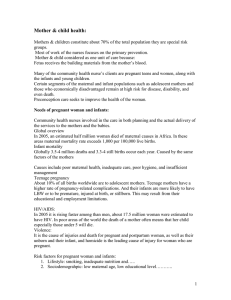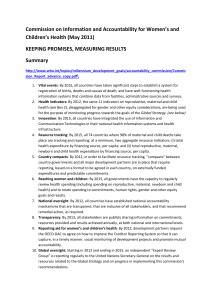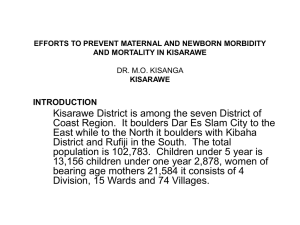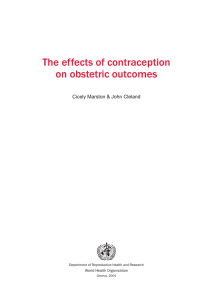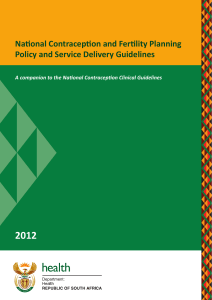CANADIAN NETWORK FOR MATERNAL NEWBORN CHILD
advertisement
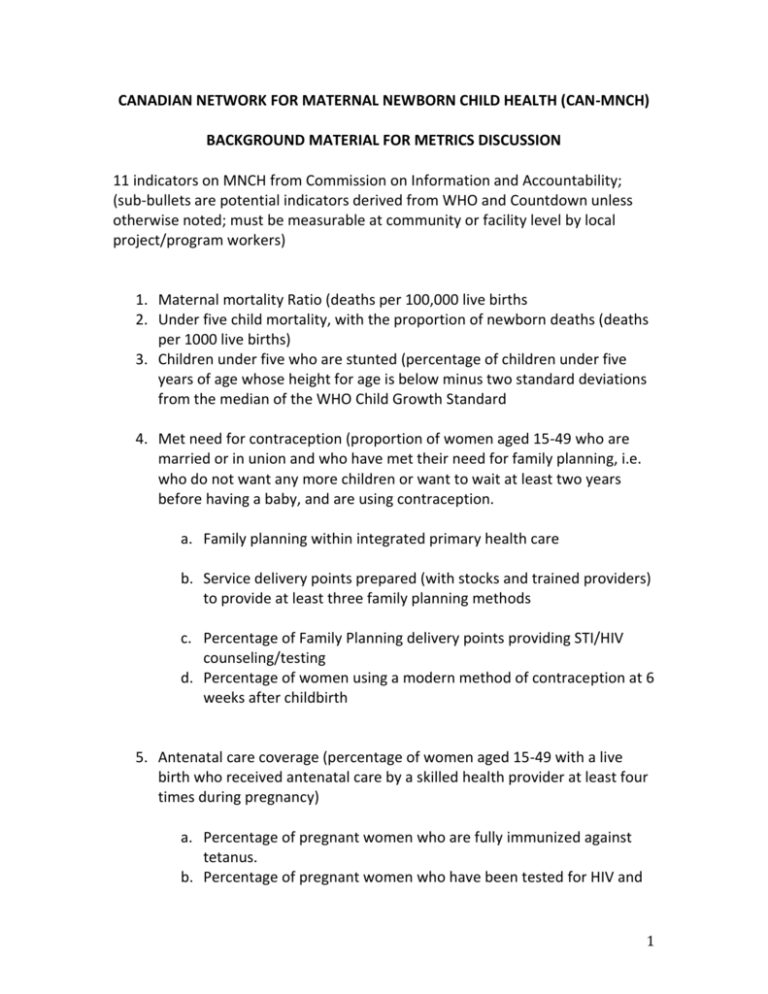
CANADIAN NETWORK FOR MATERNAL NEWBORN CHILD HEALTH (CAN-MNCH) BACKGROUND MATERIAL FOR METRICS DISCUSSION 11 indicators on MNCH from Commission on Information and Accountability; (sub-bullets are potential indicators derived from WHO and Countdown unless otherwise noted; must be measurable at community or facility level by local project/program workers) 1. Maternal mortality Ratio (deaths per 100,000 live births 2. Under five child mortality, with the proportion of newborn deaths (deaths per 1000 live births) 3. Children under five who are stunted (percentage of children under five years of age whose height for age is below minus two standard deviations from the median of the WHO Child Growth Standard 4. Met need for contraception (proportion of women aged 15-49 who are married or in union and who have met their need for family planning, i.e. who do not want any more children or want to wait at least two years before having a baby, and are using contraception. a. Family planning within integrated primary health care b. Service delivery points prepared (with stocks and trained providers) to provide at least three family planning methods c. Percentage of Family Planning delivery points providing STI/HIV counseling/testing d. Percentage of women using a modern method of contraception at 6 weeks after childbirth 5. Antenatal care coverage (percentage of women aged 15-49 with a live birth who received antenatal care by a skilled health provider at least four times during pregnancy) a. Percentage of pregnant women who are fully immunized against tetanus. b. Percentage of pregnant women who have been tested for HIV and 1 screened and treated for syphilis. 6. Antiretroviral prophylaxis among HIV-positive pregnant women to prevent vertical transmission of HIV, and antiretroviral therapy for women who are treatment-eligible a. Percentage of HIV positive pregnant women who have received ARVs for PMTCT. 7. Skilled attendant at birth (percentage of live births attended by skilled health personnel) a. Midwives authorized to administer core set of lifesaving interventions b. Percentage of births in facilities. c. Percentage of women discharged from facilities in less than 24 hours after childbirth d. Percentage of all births by Caesarean section e. Percentage of women giving birth at home; noting presence of trained health worker or not f. Uterotonic given for prevention of post-partum haemorrhage (percentage of women age 15-49 receiving a uterotonic after delivery, in facility and at home) 8. Postnatal care for mothers/babies (percentage of mothers and babies who receive 1st visit within 2 days of birth) 2 9. Exclusive breastfeeding for six months (percentage of infants aged 0-5 months who are exclusively breastfed) a. Percentage of newborn infants put to the breast within 1 hour of birth 10. Three doses of the combined diphtheria/pertussis/tetanus vaccine(percentage of infants aged 12-23 months who received three doses of DPT vaccine 11. Antibiotic treatment for pneumonia (percentage of children age 0-59 months with suspected pneumonia receiving antibiotics) Additional potential indicators: Notification system for maternal deaths (From Commission report) Health care available free of charge at point of delivery or mothers and children under five years of age. Essential priority medicines for mothers and children available/accessible free of charge at all levels, including contraception* Health worker trained and living in community providing essential basic care (FP, immunization, birth/death registration, ???) Mobile phones?? What indicator appropriate if any? Mobile phone used to collect data for program?? 3 Child: Percentage of 6-59 month children receiving 2 doses Vitamin A per calendar year Percentage of one-year-old children immunized against measles. Percentage of children 0-59 months with diarrhea who received oral rehydration therapy [including zinc] and/or increased fluids, with continued feeding. Guidelines in place for ORS for diarrhoea Children sleeping under ITNs (percentage of children under age 5 sleeping under ITNs) Malaria treatment available/accessible/affordable (percentage of pregnant women and children under 5 receiving malaria treatment after diagnosis) Rapid diagnostic test for malaria available in community/facility (? Measurable) References: *http://www.who.int/medicines/publications/A4prioritymedicines.pdf Cost-effective interventions: http://www.who.int/choice/publications/p_2005_MDG_series_Maternal_ neonatal.pdf WHO FCH essential packages 2010 4


